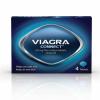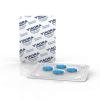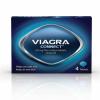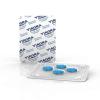Angina
Angina is a common symptom of something called coronary artery disease. Coronary artery disease means your heart muscle doesn't get enough oxygen-rich blood. Angina presents as chest pain or discomfort caused by reduced blood flow to the heart muscle.


 Pharmacist - M.B.A. (Public Health) D.I.C.
Pharmacist - M.B.A. (Public Health) D.I.C.
Angina
What is it? Angina can also be referred to as…
What is it?
Angina can also be referred to as Angina Pectoris, which is derived from the latin word 'angina' meaning "infection of the throat", the greek word 'ankhone' meaning "strangling" and the and the latin word 'pectus' meaning "chest". So it can be translated to "a strangling feeling in the chest".
Angina may be stable or unstable:
- Stable angina: (persistent, recurring chest pain that usually occurs with exertion)
- Unstable angina: (sudden, new chest pain — or a change in the pattern of previously stable angina — that may signal an impending heart attack)
- A third, a rare type of angina called variant angina (also called Prinzmetal's angina) is caused by a coronary artery spasm.
- Angina is relatively common, but can be hard to distinguish from other types of chest pain, such as the pain or discomfort of indigestion. If you have unexplained chest pain, seek medical attention right away.
How do I recognise it?
Angina symptoms include:
- Chest pain or discomfort
- Shortness of breath
- Sweating
- Anxiety
- Dizziness
- Fatigue
- Nausea
- Pain in your arms, neck, jaw, shoulder or back accompanying chest pain
The chest pain and discomfort common with Angina may be described as pressure, squeezing, fullness or pain in the center of your chest. Some people with Angina symptoms describe angina as feeling like a vice is squeezing their chest, or feeling like a heavy weight has been placed on their chest.
The severity, duration and type of angina can vary. It's important to recognize if you have new or changing chest pain. New or different symptoms may signal a more dangerous form of angina (unstable angina) or a heart attack.
Stable angina is the most common form of Angina and typically occurs with exertion and goes away with rest. If chest pain is a new symptom for you, it's important to see your health care provider to find out what's causing your chest pain and to get proper treatment. If your stable angina gets worse or changes, becoming unstable, seek medical attention immediately.
Characteristics of stable angina
- Develops when your heart works harder, such as when you exercise or climb stairs
- Can usually be predicted and the pain is usually similar to previous types of chest pain you've had
- Lasts a short time, perhaps five minutes or less
- Disappears sooner if you rest or use your angina medication
- Could feel like indigestion
- Might spread to your arms, back or other areas
- Can be triggered by mental or emotional stress
Characteristics of unstable angina (a medical emergency)
- Is usually more severe and lasts longer than stable angina, maybe as long as 30 minutes
- May not disappear with rest or use of angina medication
- Might signal a heart attack
- Occurs even at rest
- Is a change in your usual pattern of angina
- Is unexpected
Characteristics of variant angina (Prinzmetal's angina)
- Usually happens when you're resting
- Is often severe
- May be relieved by angina medication
Angina in women
A woman's angina symptoms can be different from the classic angina symptoms. For example, a woman may have chest pain that feels like a stabbing, pulsating or sharp form of chest pain rather than the more typical vise-like pressure. Women are also more likely to experience symptoms, such as nausea, shortness of breath or abdominal pain. These differences may lead to delays in seeking treatment.
What Causes angina?
Angina is caused by reduced blood flow to your heart muscle. Your blood carries oxygen, which your heart muscle needs to survive. When your heart muscle isn't getting enough oxygen, it causes a condition called ischemia.
The most common cause of reduced blood flow to your heart muscle is coronary artery disease (CAD). Your heart (coronary) arteries can become narrowed by fatty deposits called plaques. This is called atherosclerosis.
This reduced blood flow is a supply problem — your heart is not getting enough oxygen-rich blood. You may wonder why you don't always have angina if your heart arteries are narrowed due to fatty buildup. This is because during times of low oxygen demand — when you're resting, for example — your heart muscle may be able to get by on the reduced amount of blood flow without triggering angina symptoms. But when you increase the demand for oxygen, such as when you exercise, this can cause angina.
- Stable angina. Stable angina is usually triggered by physical exertion. When you climb stairs, exercise or walk, your heart demands more blood, but it's harder for the muscle to get enough blood when your arteries are narrowed. Besides physical activity, factors such as emotional stress, cold temperatures, heavy meals and smoking also can narrow arteries and trigger angina.
- Unstable angina. If fatty deposits (plaques) in a blood vessel rupture or a blood clot forms, it can quickly block or reduce flow through a narrowed artery, suddenly and severely decreasing blood flow to your heart muscle. Unstable angina can also be caused by conditions such as severe anemia, especially if you already have narrowed coronary arteries. Unstable angina worsens and is not relieved by rest or your usual medications. If the blood flow doesn't improve, heart muscle deprived of oxygen dies — a heart attack. Unstable angina is dangerous and requires emergency treatment.
- Variant angina. Variant angina, also called Prinzmetal's angina, is caused by a spasm in a coronary artery in which the artery momentarily narrows. This narrowing reduces blood flow to your heart, causing chest pain. Variant angina accounts for about 2 percent of angina cases.
How do I treat angina?
Like any disease, even if there is no cure, there is almost always something you can do to manage it and take control. There are three main areas involved in the treatment of any disease:
For information on medicines and therapies relevant to Angina, make an appointment at Lynch's pharmacy, Douglas, Cork.
Learn all about the drugs used to treat the disease and any complementary medicines or therapies proven to help. Equip yourself with the tools to manage the condition and not be managed by it.
How do you live with it?
Certain adjustments may be needed to get on with your life, and often, some simple tips and advice can go a long way to making these changes.
When you come to our Pharmacy, we give you all the information available to make your life easier and enable you to better live with your condition.
References:
1. Angina- A Comprehensive Review http://www.mayoclinic.com/health/angina/DS00994
2. What is Angina?- National Heart and Lung Blood Institute Diseases and Conditions Index http://www.nhlbi.nih.gov/health/dci/Diseases/Angina/Angina_WhatIs.html




 ,
, 
 ,
, 





